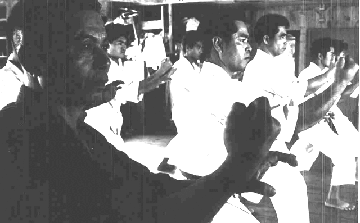One of the most misunderstood concepts students have while training,
is the relationship of our Uechi-ryu art to actual fighting.
 I often tell the story of my early training on Okinawa in the ’50s and a new student who, after his first lesson, wanted to “test” his fighting skills in a bar, just using his newly learned Sanchin!
I often tell the story of my early training on Okinawa in the ’50s and a new student who, after his first lesson, wanted to “test” his fighting skills in a bar, just using his newly learned Sanchin!
I tried to explain that Sanchin wasn’t something you could simply “turn on” and win fights, but he couldn’t be talked out of trying it out. Naturally the test ended badly for my buddy. It was embarrassing and laughable to the Marine he insulted . . . as he took his Sanchin stance and arm position, while readied to wreak havoc on his opponent. As I helped him up he told me “This Uechi crap isn’t for me!” Of course, he never returned to class, which was probably a blessing for Tomoyose sensei and for Uechi-ryu in general.
Since each of you are in different phases of training, it is important to understand where you are in relationship to training in a more “realistic” manner. Obviously, if you attempt to train on a level you are not ready for, chances are you will get injured.
Some things to keep in mind as you train:
1. Kata are the tools we use for self-defense. Kata help create the balance, timing, distancing and technique needed for self-defense applications.
2. Mindset. . . the fighting spirit you will need to “engage” in a self-defense situation and the “will to survive” are developed and strengthen in your kata.
3. Strengthening exercises and drills: are not intended to build large muscles. The purpose of Hojo Undo is to help the practitioner realize a ‘feeling’ for specific techniques. The various exercises for these weapons, are mainly intended to develop the muscles and tendons around the joints of the wrists, elbows, and shoulders; all of the important muscles and joints concerned with supporting a punching or blocking arm.
Sanchin Shime, makiwara and kotekitai practice give the practitioner an opportunity to feel the interaction of each area of the link, and to see where his weak areas lie. Like all of our practice, it is important not to injure yourself. Listen to your body and heed its advice.
4. Pre-arranged/cooperative drills, as the name implies, are fighting drills where partners know the sequence of attacks and can perform these drills without fear of getting seriously injured. However, what many students don’t understand and practice, are the different levels of performance:
a. Individual practice of the drills, where each role (attacker and defender) is learned and perfected like a kata. (by yourself)
b. Slo-mo practice with a partner. (Important to work on timing, distancing and proper hand/feet/posture relationship.
c. Medium speed – using “soft” hands. (Where the fist is not tightly closed, so any contact will not penetrate or shock)
d. Full speed with hesitation between each attack/defense sequence.
e. Full speed without hesitation between sequences.
And to add another set of variables within the kyu kumite formula, add the following three variations to the mix:
While mastering the kyu kumite drill levels, learn to perform the defenders’ role using three different methods:
a. Level one: Stepping directly to the rear with both moves. (easiest way to learn a technique)
b. Level two: First step directly to the rear with the first movement and diagonally to the rear on the second move. (movement 7 & 8 of the “8 Form drill – How many of you have mastered that one?)
c. Level three: “Surprise attack/Flinch level” – Here the defender begins with hands by his side. The attacker throws the first punch “at will” and the defender “falls back” with balance while throwing both arms up and towards attacker’s center-line. The second move is a diagonal step and regular defense/counter move.
Note: The “flinch” defensive technique is best practiced for the first three attacks.
5. Variations of the drills, One step sparring and finally free style sparring are excellent methods to hone your fighting spirit and for testing your ability to react and survive in a real fight. I’ll discuss them more in future newsletters


